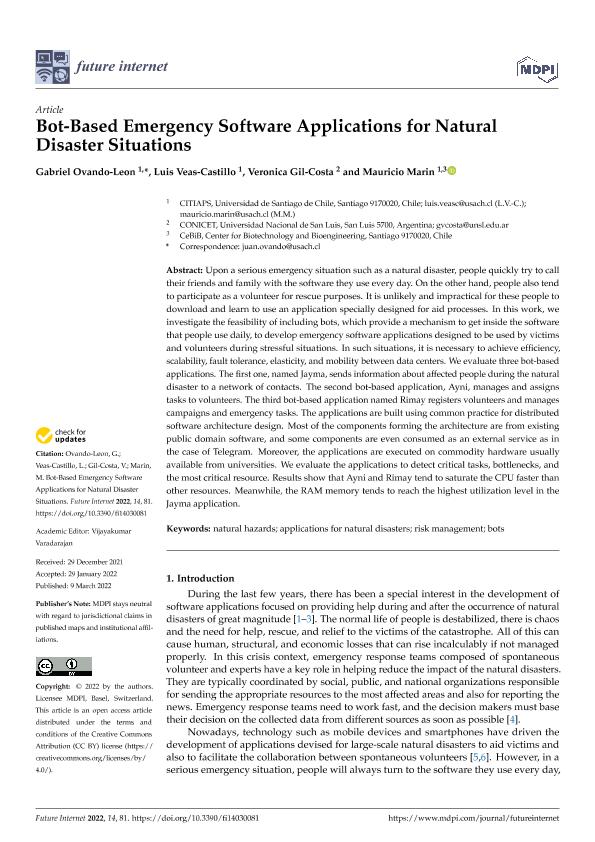Artículo
Bot-Based Emergency Software Applications for Natural Disaster Situations
Fecha de publicación:
03/2022
Editorial:
MDPI
Revista:
Future Internet
ISSN:
1999-5903
Idioma:
Inglés
Tipo de recurso:
Artículo publicado
Clasificación temática:
Resumen
Upon a serious emergency situation such as a natural disaster, people quickly try to call their friends and family with the software they use every day. On the other hand, people also tend to participate as a volunteer for rescue purposes. It is unlikely and impractical for these people to download and learn to use an application specially designed for aid processes. In this work, we investigate the feasibility of including bots, which provide a mechanism to get inside the software that people use daily, to develop emergency software applications designed to be used by victims and volunteers during stressful situations. In such situations, it is necessary to achieve efficiency, scalability, fault tolerance, elasticity, and mobility between data centers. We evaluate three bot-based applications. The first one, named Jayma, sends information about affected people during the natural disaster to a network of contacts. The second bot-based application, Ayni, manages and assigns tasks to volunteers. The third bot-based application named Rimay registers volunteers and manages campaigns and emergency tasks. The applications are built using common practice for distributed software architecture design. Most of the components forming the architecture are from existing public domain software, and some components are even consumed as an external service as in the case of Telegram. Moreover, the applications are executed on commodity hardware usually available from universities. We evaluate the applications to detect critical tasks, bottlenecks, and the most critical resource. Results show that Ayni and Rimay tend to saturate the CPU faster than other resources. Meanwhile, the RAM memory tends to reach the highest utilization level in the Jayma application.
Palabras clave:
APPLICATIONS FOR NATURAL DISASTERS
,
BOTS
,
NATURAL HAZARDS
,
RISK MANAGEMENT
Archivos asociados
Licencia
Identificadores
Colecciones
Articulos(CCT - SAN LUIS)
Articulos de CTRO.CIENTIFICO TECNOL.CONICET - SAN LUIS
Articulos de CTRO.CIENTIFICO TECNOL.CONICET - SAN LUIS
Citación
Ovando Leon, Gabriel; Veas Castillo, Luis; Gil Costa, Graciela Verónica; Marin, Mauricio; Bot-Based Emergency Software Applications for Natural Disaster Situations; MDPI; Future Internet; 14; 3; 3-2022; 1-22
Compartir
Altmétricas




